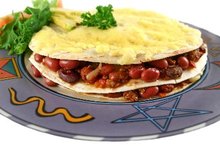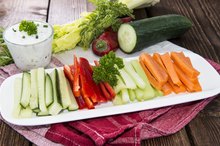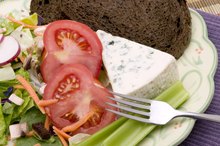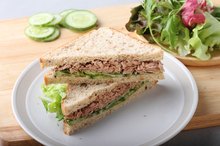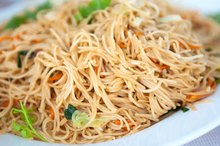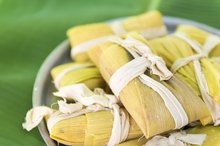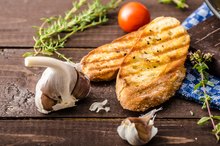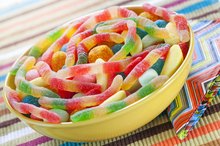Nutrition in One Fried Corn Tortilla
A fried corn tortilla is most often used to make chips, tacos or tostadas but also appears in some salad and soup recipes. Corn tortillas contain several nutrients good for your health, but they should be eaten as part of a well-balanced diet because they cannot cover all your vitamin and mineral needs. Fried corn tortillas are available in packages at most grocery stores but are also easy to make at home.
Tips
One Fried Corn Tortilla has 500 Calories and 7.14 g of Protein per 100 gram serving according to the nutrition facts provided by the USDA Food Composition Database.
Fat and Calories
Frying a corn tortilla increases fat and calorie content. A diet too high in fat increases your risk of several health conditions, including heart disease and obesity. Eating more calories than you burn may result in weight gain. A fried corn tortilla contains 111 calories and more than 7 g of fat, making them something you should limit.
- Frying a corn tortilla increases fat and calorie content.
- Eating more calories than you burn may result in weight gain.
Carbohydrates
Are Whole-Wheat Tortillas Healthy?
Learn More
Your daily calorie intake should be 45 to 65 percent carbohydrates, which are your body's main source of energy. A 2,000-calorie diet should contain 225 to 325 g of carbohydrates each day. A low-carbohydrate diet may leave you feeling weak and sluggish. A fried corn tortilla has almost 11 g of carbohydrates. MayoClinic.com recommends getting most of your carbohydrates from natural plant foods instead of processed foods because they are typically healthier.
- Your daily calorie intake should be 45 to 65 percent carbohydrates, which are your body's main source of energy.
Fiber
One fried corn tortilla has about 1.5 g of fiber. Women should get 22 to 28 g of fiber daily and men need 28 to 34 g. Fiber aids in digestion by regulating bowel function and preventing constipation. It also regulates your blood sugar and cholesterol levels, reducing your risk of diabetes and heart disease. Adding fiber-rich foods to your diet also allows you to control your appetite because fiber digests slowly, satisfying your hunger longer and preventing cravings that lead to unhealthy snacking. Balance high-fiber foods with healthy amounts of fat and calories for additional weight control 2.
- One fried corn tortilla has about 1.5 g of fiber.
- Adding fiber-rich foods to your diet also allows you to control your appetite because fiber digests slowly, satisfying your hunger longer and preventing cravings that lead to unhealthy snacking.
Protein
How Many Calories in Carrot Sticks?
Learn More
Your daily calorie intake should contain 10 to 35 percent protein or 50 to 175 g for a 2,000-calorie diet. Protein is necessary for growth and development in children and supports energy levels. It also plays a role in healthy skin, nails, hair, muscles and cells. One fried corn tortilla contains about 1.5 g of protein.
- Your daily calorie intake should contain 10 to 35 percent protein or 50 to 175 g for a 2,000-calorie diet.
- It also plays a role in healthy skin, nails, hair, muscles and cells.
Vitamins and Minerals
Corn tortillas contain small amounts of several vitamins and minerals that your body relies upon for overall health. Adding a fried corn tortilla to your meal increases your intake of calcium, magnesium, potassium, phosphorus and folic acid. These nutrients work to support healthy bones and teeth, regulate blood pressure, prevent birth defects, aid in digestion and keep your muscles functioning properly.
- Corn tortillas contain small amounts of several vitamins and minerals that your body relies upon for overall health.
- These nutrients work to support healthy bones and teeth, regulate blood pressure, prevent birth defects, aid in digestion and keep your muscles functioning properly.
Related Articles
References
- USDA Nutrient Database
- University of Massachusetts: Nutrients in Foods
- Corn, sweet, yellow, raw. FoodData Central. U.S. Department of Agriculture. Published April 1, 2019.
- Choosing good carbs with the glycemic index. Harvard Health Publishing, Harvard Medical School. Updated 2012.
- Corn. Grains & Legumes Nutrition Council. Updated 2020.
- Luna-Vital DA, Gonzalez de Mejia E. Anthocyanins from purple corn activate free fatty acid-receptor 1 and glucokinase enhancing in vitro insulin secretion and hepatic glucose uptake. PLoS ONE. 2018;13(7):e0200449. doi:10.1371/journal.pone.0200449
- Harvesting the health benefits from corn. Tufts University Gerald J. and Dorothy R. Friedman School of Nutrition Science and Policy. Updated 2013.
- Njike VY, Smith TM, Shuval O, et al. Snack food, satiety, and weight. Adv Nutr. 2016;7(5):866-78. doi:10.3945/an.115.009340
- Popcorn, air-popped, unbuttered. USDA FoodData Central. April 1, 2020
- Vitamin A: Fact Sheets for Health Professionals. National Institutes of Health, Office of Dietary Supplements. Updated 2020.
- Magnesium: Fact Sheets for Health Professionals. National Institutes of Health, Office of Dietary Supplements. Updated 2020.
- Corn Allergy. American College of Allergy Asthma & Immunology. Updated 2019.
- Corn. Non-GMO Project. Updated 2016.
- GMO Crops, Animal Food, and Beyond. U.S. Food and Drug Administration. Updated 03/04/2020
- High Fructose Corn Syrup Questions and Answers. U.S. Food and Drug Administration. Updated 2018.
- Bray GA. Energy and fructose from beverages sweetened with sugar or high-fructose corn syrup pose a health risk for some people. Adv Nutr. 2013;4(2):220-5. doi:10.3945/an.112.002816
- Different types of corn. The Popcorn Board. Updated 2020.
- Corn. USDA SNAP-Ed Connection.
- Corn. Grains & Legumes Nutrition Council. Updated 2020.
- Sweet Corn. Purdue Extension FoodLink. Updated 2014.
Writer Bio
Eliza Martinez has written for print and online publications. She covers a variety of topics, including parenting, nutrition, mental health, gardening, food and crafts. Martinez holds a master's degree in psychology.
